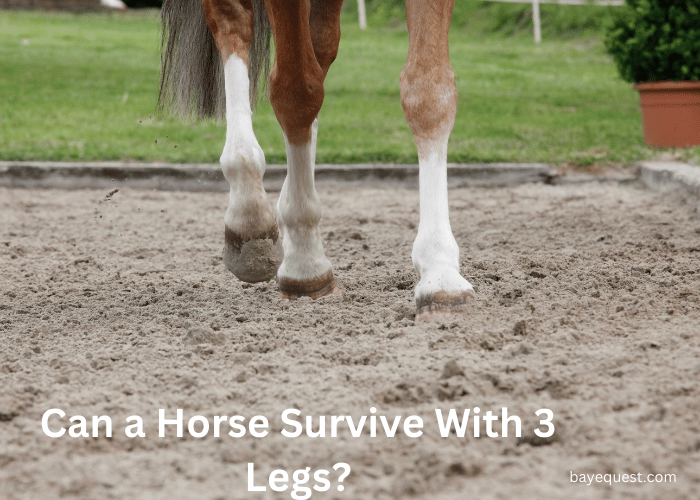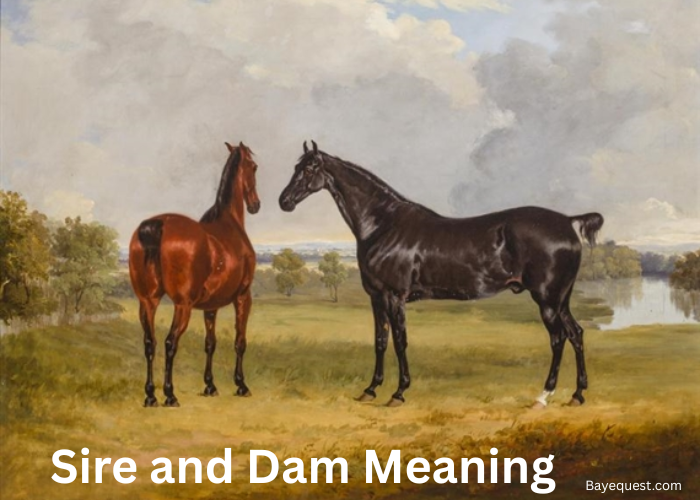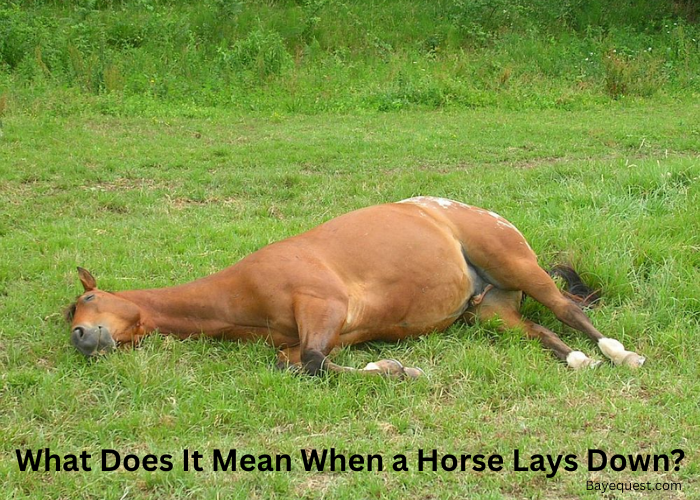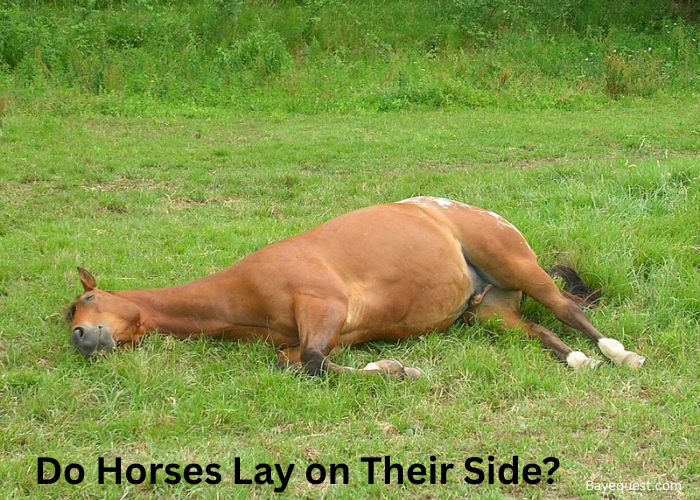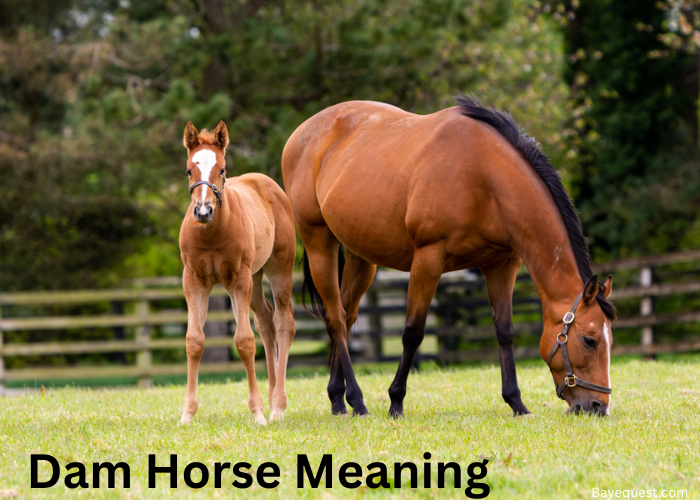A horse on three legs; it’s a tough situation to picture, but it does happen. Injuries, accidents, or even diseases can lead to a horse losing a leg.
So, can a horse live on three legs? The answer isn’t simple. Horses carry a lot of weight, and their legs do all the heavy lifting.
Losing one changes everything. But with the right care, some horses have beaten the odds.
Let’s explore what it takes for a horse to survive and thrive on three legs.
Can a Horse Survive With 3 Legs? Key Takeaway
A horse living with three legs faces many challenges, but survival is possible with the right care. Factors like age, health, and where the leg is lost matter. Proper veterinary care, a safe environment, and sometimes a prosthetic leg can help. It’s not easy, but some horses can manage a good life with three legs.
Anatomy of a Horse’s Leg
A horse’s leg is a complex structure designed for speed and strength. It consists of bones, joints, muscles, tendons, and ligaments that work together for movement and weight-bearing.
The leg is divided into the forelimb and hindlimb. The forelimb includes the shoulder blade, humerus, radius, and ulna, leading to the “knee,” which resembles a human wrist.
Below this are the cannon bone and two splint bones, ending in the fetlock joint and pastern, which provide flexibility. The hoof protects the coffin bone and contains structures like a digital cushion to absorb shock.
The hindlimb is more powerful and starts at the pelvis, connecting to the femur, tibia, and hock (similar to a human ankle).
Below the hock, it mirrors the forelimb’s structure with a cannon bone, fetlock, pasterns, and hoof.
Tendons, such as the deep and superficial digital flexor tendons, run down the leg and enable movement. Ligaments like the suspensory ligament support the joints.
Overall, a horse’s leg is built to handle immense pressure and deliver powerful strides.
However, its complexity also makes it prone to injuries, requiring careful management for a healthy, sound horse.
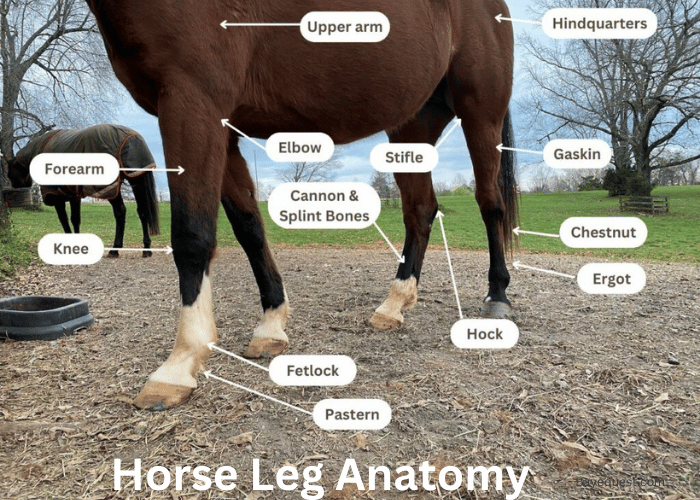
What Happens if a Horse Breaks Its Legs
When a horse breaks its leg, it’s a serious situation. Horses are heavy animals, and their legs are thin and fragile compared to their bodies.
A broken leg can be life-threatening. The pain is intense, and the horse can’t put any weight on the injured leg. Moving around becomes almost impossible.
Fixing a broken leg in a horse is tough. Unlike smaller animals, a horse can’t rest its leg easily.
It needs all four legs to stand, walk, and even lie down. Putting a cast on a horse is complicated because of the weight and the risk of other injuries.
Surgery is an option, but it’s risky and expensive. Even if the surgery goes well, recovery is long and hard.
The horse needs to stay still, which is against its nature. It’s also prone to complications, like infections or laminitis in the other legs.
Sadly, if the injury is too severe or the chances of healing are slim, euthanasia may be the kindest choice.
Though a heartbreaking decision for any owner, the well-being of the horse always comes first.
Can Horses Survive With Three Legs?
The answer isn’t simple. Horses are big, heavy animals, and their legs do a lot of work. They need all four legs for balance, movement, and carrying their weight.
Losing a leg changes everything. It puts extra strain on the other legs, which can lead to more problems down the road.
But survival isn’t impossible. Some horses can live with three legs, but it depends on a few things. The horse’s age, health, and the location of the amputation matter a lot.
Young, healthy horses have a better chance. The care they get after losing a leg is just as important.
They need a safe environment, proper medical care, and sometimes a prosthetic leg to help them move.
There are stories of horses living good lives on three legs. With the right care, they can still graze, play, and even trot around.
But it takes a lot of effort, time, and resources. The decision to keep a three-legged horse is never easy.
It’s about weighing the horse’s quality of life and the commitment needed to give them the best chance to live comfortably.
Common Causes Leading to Loss of a Horse’s Leg
Losing a leg is rare for horses but can happen in some tough situations. There are several reasons why a horse might lose a leg, and they’re often serious.
Here are the most common causes:
Severe injuries are a big one. Horses can break a leg in accidents, like falls, kicks, or getting caught in fencing. A bad break, especially in the lower leg, is hard to fix. Sometimes, if the damage is too great, amputation is the only choice.
Bone fractures are another cause. If a fracture is too severe or doesn’t heal right, it can lead to further damage. A leg that can’t heal properly might have to be removed to stop the horse from suffering.
Infections can be deadly. If a wound gets infected and antibiotics don’t work, the infection can spread to the bone. This makes it very painful and risky for the horse. In some cases, removing the leg is the only way to save the horse’s life.
Diseases like cancer or laminitis can also lead to amputation. Laminitis, in particular, is a painful condition that affects the hooves. If it gets too bad and the hooves can’t support the horse anymore, amputation may be considered.
Each situation is unique, but they all require serious care and attention.
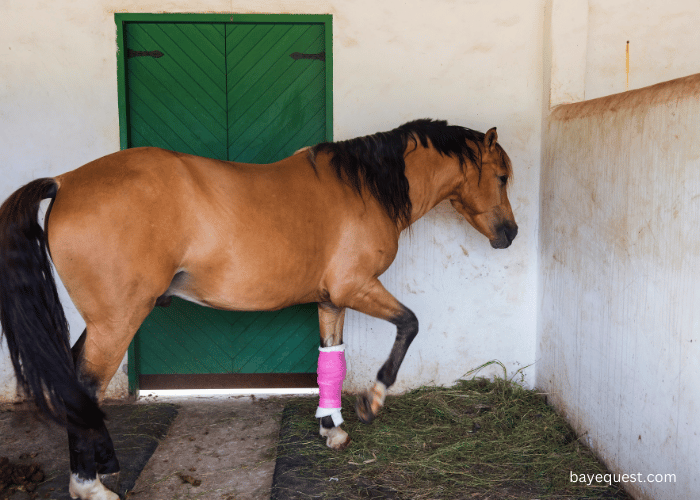
Why Horses Don’t Recover Easily From Broken Legs
Horses don’t recover easily from broken legs, and there are a few big reasons why.
First, horses are heavy animals. They weigh a lot, often over a thousand pounds. All that weight rests on four slim legs.
When one breaks, the other three have to carry even more weight, which can cause more stress and injury.
Second, a horse’s leg has many bones, joints, tendons, and ligaments packed tightly together. When a bone breaks, it’s not just the bone that’s affected.
Nearby tissues can get damaged too, making it hard for the leg to heal properly. Plus, their legs are long and slender with limited muscle, so there isn’t much padding to protect the broken area.
Third, horses need to stand and move around to stay healthy. Lying down for too long can lead to other health problems, like breathing issues or even colic.
But moving on a broken leg can cause more damage, making recovery nearly impossible.
Lastly, putting a cast on a horse is tricky. Their legs are not like a dog’s or a human’s. A cast can cause sores, poor blood flow, or make it hard for the horse to move naturally.
All of these reasons together mean that recovery from a broken leg is very challenging for horses.
The Challenges of Living With Three Legs
The challenges a horse faces when living with three legs include:
1. Balance and stability issues. Horses rely on four legs for balance. With only three, they struggle to stay steady, making simple movements more challenging.
2. Increased strain on remaining legs. The other three legs have to bear more weight and strain, leading to potential problems.
3. Difficulty with basic movements. Activities like walking, running, standing, or getting up from lying down become much harder and riskier.
4. Higher risk of injury. The remaining legs are more prone to injuries due to the extra load and the chance of stumbling or falling.
5. Mental and emotional challenges. Horses can feel anxious, scared, or frustrated as they adjust to life with three legs, affecting their behavior and mood.
6. Need for specialized care. Ongoing care includes regular vet checkups, the potential use of prosthetics, special shoes, and a controlled environment to avoid further injuries.
7. Increased medical and maintenance costs. The care and equipment required for a three-legged horse can be costly.
8. Limited mobility and activity. Reduced ability to engage in normal activities like grazing, playing, or interacting with other horses.
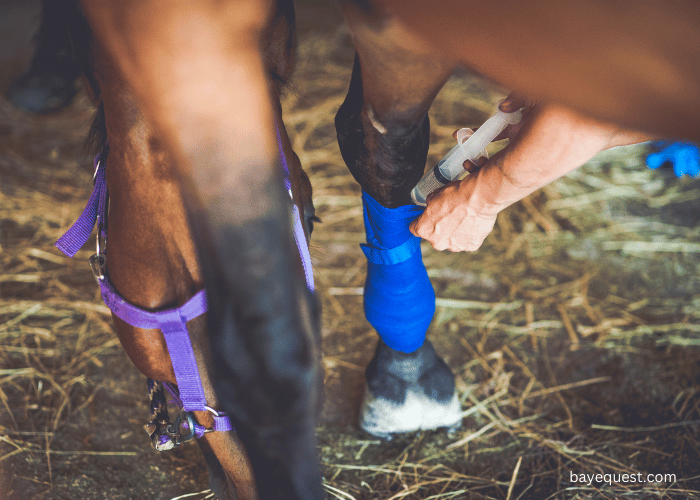
Amputation and Prosthetic Options for Horses
Amputation in horses is a serious decision and not taken lightly. When a horse loses a leg, it’s usually due to severe injury, infection, or disease where there are no other options.
The process of amputation is risky. Horses need to be under anesthesia, which in itself can be dangerous due to their size and weight.
After the surgery, the recovery is tough. The horse needs to adjust to life on three legs, which is not easy.
Prosthetics can sometimes help a horse adapt. A prosthetic leg can provide some support and balance, but it’s not a one-size-fits-all solution.
The fit has to be perfect, or it can cause sores, pain, or even more damage. A prosthetic must be strong enough to handle the horse’s weight yet flexible enough to move naturally.
The cost is also high. Creating and maintaining a prosthetic for a horse isn’t cheap. It involves frequent vet visits, custom fittings, and ongoing care.
But for some horses, a well-fitted prosthetic can give them a new lease on life. They might be able to walk, graze, and even trot around with the right support.
It’s a commitment, but one that can pay off for the right horse and situation.
Interesting read: Degloved Horse Hoof Treatment.
3 Legged Wild Horses Vs Domesticated Horses
A three-legged horse in the wild has it much tougher than a domesticated one. In the wild, survival is all about strength and speed.
A horse with only three legs can’t run fast or escape predators. It can’t keep up with the herd, either.
Every day becomes a fight for life. Finding food and water is hard. Every step is a struggle.
The other horses might leave it behind. Predators see it as easy prey. Sadly, in the wild, a three-legged horse doesn’t stand much of a chance.
Domesticated horses, on the other hand, have a better shot. They have people to care for them.
With a caring owner, a three-legged horse gets medical help, food, and a safe place to live. It doesn’t need to run from danger or search for food.
If it’s a good candidate, it might even get a prosthetic leg to help it move around. The challenges are still there, but with support, a domesticated horse can live a more comfortable life.
The key difference? Support. In the wild, it’s survival of the fittest. At home, it’s survival with a helping hand.
Conclusion
A horse surviving with three legs is no easy thing. It takes the right care, the right conditions, and a whole lot of heart.
Some horses can make it, even thrive, with the right support and love. But it’s a big challenge, both for the horse and the owner.
Every case is different, and it’s about finding the best path forward. With the right help, some horses can still lead a good life, even on three legs. It’s all about giving them that chance.




